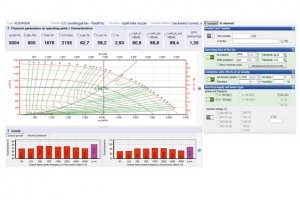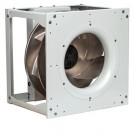The catchword “Green IT” is on everyone’s lips now – energy-conscious behaviour is indispensable these days precisely in conjunction with the indispensable cooling in data centres. Particularly in light of ever-increasing computing power, it pays off to switch to energy-efficient fans. State-of-the-art EC technology can contribute a lot to this, for example, by sparing the environment and the operator’s wallet. There is no end in sight to the growth of data centres. Trends such as mobile internet, cloud computing and internet TV require ever-higher outputs, since the volume of data is continuously rising. As a result, data centres have turned into considerable energy consumers. As early as 2008, commercial data centres in Germany were using around 10 terawatt-hours of electricity, which corresponded to just under 2 % of the overall energy consumption. This value will increase even more in future if data centre operators and people responsible for facilities and IT departments do not invest in thermal optimisation. Real-world applications show that 35 to 50 %, thus about half of the energy demand of a data centre, is required for the cooling alone. Herein lie enormous potential energy savings, especially for air-conditioning technology. Now there are state-of-the-art data centres that operate with a PUE (power usage effectiveness) value of approximately 1.1. The PUE value describes the ratio of energy demand by the actual IT hardware and the overall energy consumption of a data centre. Thus this key figure is a measure for the efficiency of the non-IT-relevant environment, in particular, of air-conditioning technology. In the case of conventionally operated data centres, the PUE value should be about 1.9, that is, nearly half of the overall energy consumption is not used for the computing power and therefore does not serve the actual purpose of a data centre.
Low energy consumption by means of free cooling

Figure 1: Free cooling in the data centre. The central component is called a FanGrid; this is a trade fair exhibit.
The palette of cooling options for data centres is wide-ranging. This is necessary because there will be no universal solution in the future either. After all, structural conditions have just as much influence on the selection as the technology used or the climatic conditions at the location. Therefore local cooling concepts, such as a direct server cooling system in the rack, are just as appropriate as concepts for cooling entire data centre areas or even the entire building complex with a central unit. To do this, operators of data centres are increasingly relying on what is called free cooling. It operates without energy-intensive chillers and uses the data centre’s ambient air. An important role is played, for example, by multiple fans operating in parallel, which provide for the defined intake and exhaust air flows within the building. Such “FanGrids” can be put together in practically any size and arrangement to achieve an ideal adaptation to the respective conditions (figure 1). The modular design makes the systems scalable, and the user can choose whether to use multiple small fans or fewer large fans.
EC technology brings advantages

Figure 2: The RadiPac series is available with a drive output from 500 watts to 12 kilowatts in outer diameter sizes from 250 mm to 1,250 mm.
ebm-papst is the world market leader in the field of EC technology and has been represented for many years in the area of data centre cooling. The fan specialist has propelled this field forward and, on this basis, is offering solutions for energy-efficient concepts with a wide selection of suitable fans. The new “radiPac” product line (figure 2) combines high flexibility provided by the frame design with maximum output, precisely for applications requiring a moderate operating pressure.

Figure 3: The “radiCal” centrifugal fan for applications in ventilation and air-conditioning technology. The impellers of the fans are matched perfectly to the motor and electronics to attain a high-efficiency total solution.
Flow rates of up to 35,000 m³/h per fan are possible here. Depending on the desired operating point, however, other fans from the comprehensive product range of the Mulfingen-based specialist lend themselves to the task. The “RadiCal” series (figure 3), for example, was developed based on the core competencies in fluid mechanics, motor technology and electronics. The RadiCal centrifugal fans feature particularly low noise emissions and reveal their strengths especially well in the low pressure range. These centrifugal fans are currently available in the sizes 133 to 630 with drive outputs between 35 W and 3 kW. The attainable flow rates reach up to 15,000 m³/h per fan. Whether operating under full load or especially under partial load, both fan series operate with high efficiency and are exceptionally quiet.
Controllability, bus networking, redundancy and long service life
Another advantage is the compact dimensions of the fans. The electronically commutated external rotor motor is directly integrated into the impeller, which dramatically reduces the installation dimensions. The electronics integrated in the drives are not only ideally matched to the EC motors used, they can also be controlled with either a 0-10 V analogue signal or digitally with a MODBUS interface. For the FanGrids in which many fans are used in parallel, the bus networking offers advantages: from making configurations during commissioning to performing service, alarm diagnosis and maintenance, dealing with the technology becomes substantially easier if the technician can use a central computer to access the fans. Moreover, by means of the MODBus interface the fans from ebm-papst can be integrated into a BMS (Building Management System) or DCIM (Data Center Infrastructure Management). This interface makes the motor speeds continuously variable, which provides a very convenient option for demand-oriented performance adaptation. Thus the air performance of the FanGrids can be perfectly matched to the specific ambient and operating conditions of the data centre. At the same time, it is easy to incorporate the necessary redundancy in the event of a fan failure. The speed of the “neighbouring fans” is increased so that the same air flow is maintained.

Leave a comment